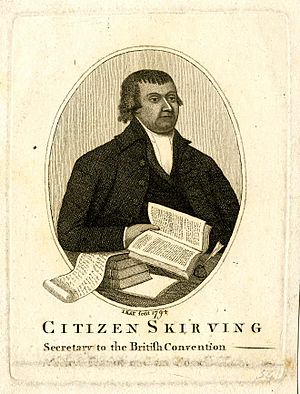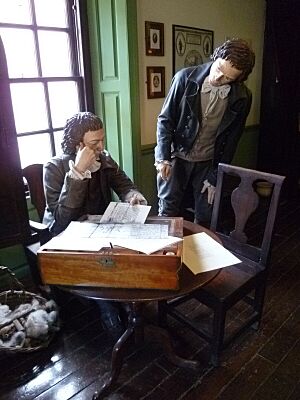William Skirving facts for kids
William Skirving (around 1745 – 1796) was one of five brave Scots known as the Scottish Martyrs for Liberty. These men believed everyone should have the right to vote. They were inspired by the French Revolution and wanted to make big changes in Britain.
Because of their ideas, they were accused of breaking laws against the government in 1793–94. As punishment, they were sent far away to a new colony in New South Wales, Australia.
Contents
Early Life
William Skirving was born around 1745 in Liberton, a village near Edinburgh, Scotland. His father, also named William, was a farmer. Young William went to school at Haddington grammar school and then to Edinburgh University.
He first thought about becoming a minister in the church. But after a short time studying religion, he changed his mind. He became a tutor in a private home. Later, he started farming by leasing land at a place called Damhead.
In 1775, William married Rachel Abercrombie. She had inherited land in Fife from her father. William began farming there. He and Rachel had two sons, William (born 1779) and Alexander (born 1782).
In 1792, William moved to Edinburgh. He even published a book about farming. He hoped to become a professor of agriculture at Edinburgh University, but he didn't get the job.
Fighting for Change
In 1792, William Skirving became very active in a group called the Edinburgh Society of Friends of the People. This group was made up of people who wanted to change the government. They were inspired by the ideas of the French Revolution.
The Friends of the People
The Friends of the People wanted everyone to have the right to vote. They also wanted elections to happen every year. They hoped to connect with other groups who shared their ideas, like the United Irishmen.
The Society said they did not want riots or a revolution. They wanted to change laws through peaceful means in Parliament. However, the British Government saw their ideas as a big threat.
Standing Up for Rights
William Skirving was chosen as the main secretary for the Society's first big meeting in December 1792. At that time, only the French and American Revolutions had held similar large meetings.
Other leaders of the group, like Thomas Muir and Thomas Fyshe Palmer, were arrested for speaking out. William Skirving bravely stayed on as secretary. He even helped publish a report about Thomas Fyshe Palmer's trial.
By the third big meeting, many wealthy supporters had left the Society because they were scared. But this meeting became even more important. Representatives from English groups joined, making it a national event. They even started calling each other "Citizen," like in France.
During this meeting, William Skirving was arrested along with Maurice Margarot and Joseph Gerrald. The government thought this meeting was dangerous because of its goals for voting rights. Skirving was accused of sharing a pamphlet that the government didn't like. He was also accused of organizing meetings that were seen as rebellious.
After his trial in January 1794, William Skirving was sentenced to be sent away for fourteen years.
A Long Journey to Australia
William Skirving spent about a month in Newgate Prison. In February, he was put on a ship called the Surprize. Other Scottish Martyrs, Fyshe Palmer, Margarot, and Muir, were also on board. They waited on the ship until it sailed in May.
The men were allowed to buy better cabins and comforts for their long journey. Margarot's wife even traveled with him to New South Wales. Some friends of Fyshe Palmer also came along as free settlers.
During the voyage, the ship's captain claimed there was a plot. He said Fyshe Palmer and Skirving were planning a mutiny to sail the ship to France. This claim came from a man who disliked the Scotsmen. The captain praised Margarot, but Fyshe Palmer believed Margarot had been tricked into giving false information.
The captain locked Skirving and Fyshe Palmer in a small cabin. They lost the comforts they had paid for. Other prisoners accused of being part of the plot were whipped and kept in chains.
Skirving and Fyshe Palmer wrote to the Governor of New South Wales. They said they were innocent and that the captain had lied about them. When the ship arrived, the whole matter was dropped. No one was charged.
Life in a New Land
In New South Wales, the men were treated more like gentlemen, even though they were prisoners. Each was given their own small house. Skirving's house was near a stream, close to Fyshe Palmer's and Muir's homes.
Friends and supporters had sent money to help them. This meant they didn't have to work for the government. The Governor was told to give the Martyrs a lot of freedom. He was also told not to look for any "rebellious" books they might have brought.
Skirving bought several pieces of land. He put them together to create a farm of about 100 acres (0.4 km2) at Petersham. He worked very hard at farming.
However, he was disappointed because money he expected from supporters in Britain did not arrive. This left him with some debts. His farming efforts were also not very successful. He missed his wife and family very much, and his health got worse.
He became sick with yellow fever around January 1796. William Skirving sadly died of dysentery in March of that year.
Remembering the Martyrs
Years later, the idea of changing Parliament became popular again. People remembered the Scottish Martyrs. In 1837, a Scottish politician named Joseph Hume suggested building two memorials for them. One would be in Edinburgh and one in London.
Money was collected from people who supported the idea. Joseph Hume laid the first stone for the Edinburgh monument in 1844. He also laid the first stone for the London monument in 1852. At that time, Hume was the main person in Parliament who supported the idea of everyone having the right to vote.
The plaque on the Edinburgh memorial says it was built "by the Friends of Parliamentary Reform." The Edinburgh memorial is a tall, pointed stone pillar in the Old Calton Cemetery. The London memorial is also a tall pillar, about 33 ft (10 m) high, in Nungate cemetery.
See also
- List of convicts transported to Australia




